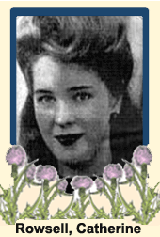Newfoundland War Brides
 |
 |
 |
August 2007 Lin Crosbie-Marshall |
www.downhomelife.com August 2007
The following story is an exerpt from the article "Of Love and War" from the August 2007 edition of the Downhome magazine. It is posted with the permission of the Downhome magazine and its author Lin Crosbie-Marshall. The original article has been divided into three parts and can be viewed separately on this web site in the "Stories" section under the names of the war brides Marion Hann, Mary Hann, Catherine Rowsell and Eileen Hamlyn.
Introduction
Lin Crosbie-Marshall discusses courtship and cultural connections with four Corner Brook women who left Scotland over 60 years ago, and followed their soldier husbands to western Newfoundland.
The bonds of love forged during wartime are often so strong they cannot be severed by time, distance, or even death. In the early 1940s, as bombs shattered the tranquility of Europe’s cities and countryside, love was busy blitzing its way into the hearts of four young men from Newfoundland and four young women from Scotland.
In the wake of the Second World War, nearly 50,000 brides from Great Britain followed their soldier husbands to Canada. Many came to this province and several from Scotland settled in western Newfoundland. Now, more than six decades later, Downhome spoke with four of these “war brides” in Corner Brook, who enjoy a common heritage and friend-ship cemented during their weekly Scottish dancing classes. Here, they share their wartime love stories and their memories of how they created new lives for themselves an ocean away from home.
...Four women and four stories of sacrifice, adaptation and, most of all, love. They can sum up their lives as Scottish war brides in Newfoundland with two words: No regrets.
Part I
Catherine Rowsell
Like Marion, Catherine Rowsell (nee Anderson) still misses her husband, Alex, who died in 1992. She met Alex Rowsell, a member of the Canadian Highland Light Infantry, in 1945 in Edinburgh. He was on leave and visiting one of his married brothers who lived in Scotland’s capital. “I didn’t even think about rationing and brought him home to dinner – but somehow my mother managed,” Catherine says, smiling at the memory.
They married in 1946, much to the dismay of Catherine’s parents, who didn’t want their 18-year-old daughter to leave her home and native country. “But I was a stubborn Scot and determined to make a go of it,” Catherine asserts.
She sailed from Liverpool aboard the Letitia in September 1946 and, surprisingly, enjoyed the voyage. As a woman travelling alone, she had to sleep in what she describes as “hammocks” – only women with children were assigned bunks. But inured to the severe rationing in Scotland, Catherine thoroughly enjoyed the plentiful supply of food onboard, saying, “It was the first time in a long time that I saw white bread and fruit.”
Alex met his new bride in Halifax, Nova Scotia, and the couple journeyed to Port aux Basques, then on to Corner Brook. Catherine’s first thought upon seeing Port aux Basques was, “What am I doing here?” Her arrival in Corner Brook provoked a similar reaction, “but the Newfoundlanders were so wonderful and the people so kind,” Catherine says, that she quickly adjusted to her new home. She also befriended a few war brides from the First World War. Her job with an insurance company and visits to Scotland assuaged her homesickness.
Catherine and Alex lived with his parents for about a year before they scraped together $500 – “an absolute fortune at that time,” she says – as down payment on one of the homes being built for war veterans. Catherine still lives there today, along with her only child, Catherine, and her son-in-law, Keith.

| Yearbook | References | Citizenship | Photo Album | Links |
| Submit Info | Contact Us | Comments |